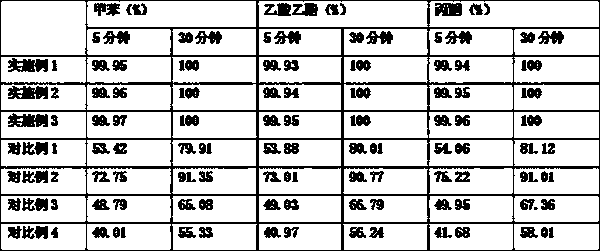Composite nano material for degrading VOC gas and preparation method thereof
A composite nanomaterial and gas technology, which is applied in the field of composite nanomaterials for degrading VOC gas and its preparation, can solve the problems of secondary pollution, long degradation time, large differences in the degradation efficiency of harmful gases, etc. , the effect of improving the photocatalytic performance
- Summary
- Abstract
- Description
- Claims
- Application Information
AI Technical Summary
Problems solved by technology
Method used
Image
Examples
Embodiment 1
[0034] A preparation method of a composite nanomaterial for degrading VOC gas, the specific steps are as follows:
[0035] (1) Using multi-walled carbon nanotubes as raw materials, boron and phosphorus are co-doped to obtain doped multi-walled carbon nanotubes;
[0036] (2) Then modify the doped multi-walled carbon nanotubes with methyltris(cyclohexylamino)silane to obtain modified doped multi-walled carbon nanotubes;
[0037] (3) Then compound the modified doped multi-walled carbon nanotubes with bismuth tungstate to obtain a complex;
[0038] (4) Finally, the complex is reacted with p-aminobenzaldehyde and isoniazid, and modified with polyethyleneimine to obtain the composite nanomaterial for degrading VOC gas.
[0039] The specific method of step (1) is: first acidify 10mol of multi-walled carbon nanotubes, and then ultrasonically disperse them in water to obtain a dispersion; then add 0.1mol of boric acid and 0.6mol of pyrophosphoric acid into the dispersion, in an inert ...
Embodiment 2
[0047] A preparation method of a composite nanomaterial for degrading VOC gas, the specific steps are as follows:
[0048] (1) Using multi-walled carbon nanotubes as raw materials, boron and phosphorus are co-doped to obtain doped multi-walled carbon nanotubes;
[0049] (2) Then modify the doped multi-walled carbon nanotubes with methyltris(cyclohexylamino)silane to obtain modified doped multi-walled carbon nanotubes;
[0050] (3) Then compound the modified doped multi-walled carbon nanotubes with bismuth tungstate to obtain a complex;
[0051] (4) Finally, the complex is reacted with p-aminobenzaldehyde and isoniazid, and modified with polyethyleneimine to obtain the composite nanomaterial for degrading VOC gas.
[0052] The specific method of step (1) is: first acidify 10mol of multi-walled carbon nanotubes, and then ultrasonically disperse them in water to obtain a dispersion; then add 0.2mol of boric acid and 0.5mol of pyrophosphoric acid into the dispersion, and inert at...
Embodiment 3
[0060] A preparation method of a composite nanomaterial for degrading VOC gas, the specific steps are as follows:
[0061] (1) Using multi-walled carbon nanotubes as raw materials, boron and phosphorus are co-doped to obtain doped multi-walled carbon nanotubes;
[0062] (2) Then modify the doped multi-walled carbon nanotubes with methyltris(cyclohexylamino)silane to obtain modified doped multi-walled carbon nanotubes;
[0063] (3) Then compound the modified doped multi-walled carbon nanotubes with bismuth tungstate to obtain a complex;
[0064] (4) Finally, the complex is reacted with p-aminobenzaldehyde and isoniazid, and modified with polyethyleneimine to obtain the composite nanomaterial for degrading VOC gas.
[0065] The specific method of step (1) is: first acidify 10mol of multi-walled carbon nanotubes, and then ultrasonically disperse them in water to obtain a dispersion; then add 0.15mol of boric acid and 0.55mol of pyrophosphoric acid into the dispersion, in an iner...
PUM
 Login to View More
Login to View More Abstract
Description
Claims
Application Information
 Login to View More
Login to View More - R&D
- Intellectual Property
- Life Sciences
- Materials
- Tech Scout
- Unparalleled Data Quality
- Higher Quality Content
- 60% Fewer Hallucinations
Browse by: Latest US Patents, China's latest patents, Technical Efficacy Thesaurus, Application Domain, Technology Topic, Popular Technical Reports.
© 2025 PatSnap. All rights reserved.Legal|Privacy policy|Modern Slavery Act Transparency Statement|Sitemap|About US| Contact US: help@patsnap.com

